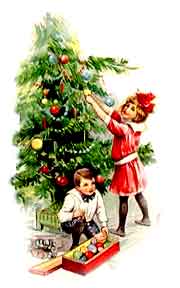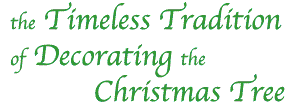

Enter any department store from now until New Year’s and aisles packed with plastic ornaments, glistening garland, and blinking lights will greet you at every turn. What was once a simple family tradition has become a multimillion-dollar industry with decorations becoming more elaborate and costly each year. Where did this tradition begin and how did it become such an integral part of the holiday festivities?
Like the majority of practices associated with Christmas, the tradition arose from the intermingling of ancient Roman beliefs and the spreading Christian religion. Early Christians believed certain trees flowered unseasonably on Christmas Eve as homage to Jesus’ birth. This belief combined with the Roman practice of decorating their homes with greenery for the New Year formed the basis of our modern fascination with icicles and fancy angel tree toppers.
The decorating of various structures and trees has been recorded in Europe from the 17th century on, but the first written account of a “Christmas tree” did not appear until 1605. According to John Matthew’s The Winter Solstice, an anonymous German citizen that year recorded trees being decorated with “roses cut out of many colored paper, apples, wafers, gold-foil, [and] sweets”. What about chaser lights and oodles of wrapped gifts? It was more than 100 years later when Professor Karl Gottfried Kissling of the University of Wittenburg wrote of people adding candles for decorations and placing children’s wrapped branches around the bottom of the small indoor trees.
Even though the practice was initially condemned by religious leaders, it spread from Germany to Finland through Norway and Denmark. In 1840, Queen Victoria and Prince Albert of England endorsed the tradition by displaying their own ornately decorated tree at their palace. By the early 1900s, decorating the tree was as much a part of Christmas as Santa Claus and opening presents.
Of course, the early trees were decorated differently than today’s evergreens. Early ornaments were usually hand-crafted or edible. Nuts, candies, fruits, and pieces of colored paper were the most common. The average modern tree is decorated with a combination of store-bought ornaments and family memorabilia with several strings of lights strewn over the branches instead of candles, but no matter how the tree is decorated it still symbolizes a timeless Christmas tradition of families gathered together exchanging presents and love.
Like the majority of practices associated with Christmas, the tradition arose from the intermingling of ancient Roman beliefs and the spreading Christian religion. Early Christians believed certain trees flowered unseasonably on Christmas Eve as homage to Jesus’ birth. This belief combined with the Roman practice of decorating their homes with greenery for the New Year formed the basis of our modern fascination with icicles and fancy angel tree toppers.
The decorating of various structures and trees has been recorded in Europe from the 17th century on, but the first written account of a “Christmas tree” did not appear until 1605. According to John Matthew’s The Winter Solstice, an anonymous German citizen that year recorded trees being decorated with “roses cut out of many colored paper, apples, wafers, gold-foil, [and] sweets”. What about chaser lights and oodles of wrapped gifts? It was more than 100 years later when Professor Karl Gottfried Kissling of the University of Wittenburg wrote of people adding candles for decorations and placing children’s wrapped branches around the bottom of the small indoor trees.
Even though the practice was initially condemned by religious leaders, it spread from Germany to Finland through Norway and Denmark. In 1840, Queen Victoria and Prince Albert of England endorsed the tradition by displaying their own ornately decorated tree at their palace. By the early 1900s, decorating the tree was as much a part of Christmas as Santa Claus and opening presents.
Of course, the early trees were decorated differently than today’s evergreens. Early ornaments were usually hand-crafted or edible. Nuts, candies, fruits, and pieces of colored paper were the most common. The average modern tree is decorated with a combination of store-bought ornaments and family memorabilia with several strings of lights strewn over the branches instead of candles, but no matter how the tree is decorated it still symbolizes a timeless Christmas tradition of families gathered together exchanging presents and love.
Amy can be reached via email at amy@mymerrychristmas.com. This article appears courtesy of The Merry Syndicate at www.mymerrychristmas.com with our best wishes for a warm and merry holiday season. All copyrights reserved.
